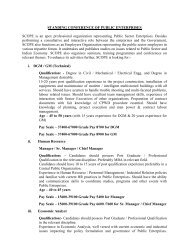Skill Development - scope
Skill Development - scope
Skill Development - scope
You also want an ePaper? Increase the reach of your titles
YUMPU automatically turns print PDFs into web optimized ePapers that Google loves.
CHAIRMAN’S DESK<br />
India is passing through a phase of unprecedented<br />
demographic change where the working-age<br />
population, aged between 15 and 64,<br />
will rise by around 12 million every year in the next<br />
two decades. In 2020, the average Indian will be<br />
only 29 years old, compared with 37 in China and<br />
the US, 45 in West Europe and 48 in Japan, making<br />
India one of the young nations in the world.<br />
The age advantage of the nation is slated to continue<br />
for at least three decades till 2040. As such,<br />
we indeed have a great opportunity in our hands<br />
to leverage the nation’s young human resource<br />
to help grow our country economically.<br />
This increased labor force will benefit India only<br />
if the population is appropriately skilled. It is estimated<br />
that 90% of jobs in the manufacturing<br />
sector in India are “skill-based” and require vocational<br />
training. However, among Indian youth in<br />
the 15-29 year age group, the proportion of those<br />
who have undergone formal vocational training<br />
is much lower than required.<br />
Government has therefore given top priority to<br />
the agenda of skill development and aims to increase<br />
the percentage of workforce with formal<br />
skills in the coming years. It has set a target of creating<br />
500 million skilled people by 2022, pursuant<br />
to formulation of National <strong>Skill</strong> <strong>Development</strong><br />
Policy 2009.<br />
8 Kaleido<strong>scope</strong> July 2013













